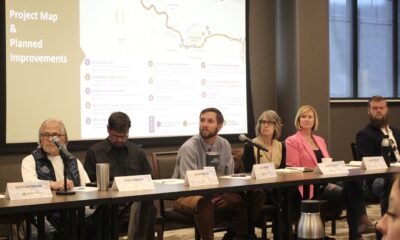Uncategorized
From Jackie with Love: Golf gets greener
Published
7 years agoon
Posted By
Outlaw Partners

By Jackie Rainford Corcoran EBS Health Columnist
In Big Sky, home to approximately 2,500-year round residents, there are four 18-hole golf courses. While researching lawn maintenance, I became curious about how the managers of our courses are responding to the growing concern over the health and environmental impacts of using chemical lawn products. So I called them.
I was immediately put in touch with the superintendent of each course. To my delight, they are all environmentally proactive with a thorough and practiced plan in place.
While each has a unique approach, there are overlapping methods. These include spraying chemicals only when and where necessary (which involves a more time-consuming spraying-by-hand method), using more eco-friendly items like granular products over sprays when possible, working with consulting firms, keeping tight control on water usage, and creating natural buffer zones between the greens and wetlands.
Ryan Blechta of Spanish Peaks is proactive when it comes to protecting the Gallatin River watershed. He says he and his team are going through the rigorous process of becoming certified by Audobon within the next five years. The Audubon Cooperative Sanctuary Program for Golf Courses was initiated in 1991 by the Audobon International, a non-profit environmental organization dedicated to conservation. Today, 354 courses in the United States have met their requirements, which work to ensure that wildlife like birds and fish living on and near golf courses are safe in their habitat.
Mike Wilcynski, Moonlight’s former superintendent and now general manager, holds extra tight reins on water consumption. Every sprinkler head is individually controlled to prevent random and excessive watering. He says their greens play firm and fast. “While they might not be emerald green all the time, which comes with higher water and fertilizer usage, we are leaving a lighter footprint,” Wilcynski said.
Bob Clarkson of the Yellowstone Club said he holds environmental stewardship as a top priority.
They implement the Best Management Practices Guide for Environmental Sustainability created by the Golf Course Superintendents Association of America. Key components of their practices are water conservation, water quality protection, pollution prevention, energy conservation and integrated pest management, a program that seeks to reduce pesticide use by using a variety of practices to control or manage pests.
Water testing by the Gallatin River Task Force (GRTF) is in place on both the South Fork and West Fork below the Yellowstone Club. “These stations monitor real-time temperature, conductance and water levels. Nutrient data is also collected throughout the year. This monitoring process ensures that any potential issues would be detected,” Clarkson said.
Big Sky’s Sam Woodger notes that over the last six years they’ve been working closely with GRTF. This has led to receiving grant money that made it possible to refurbish three sections of the Gallatin River where there was erosion along the creek bank. “We planted willow and sedge to build up a buffer zone,” Woodger said. “We also planted over 2,000 willow cuttings along water edges to prevent nitrate uptake.”
There are occasionally noticeable algae blooms in waterways near local golf courses. I contacted GRTF Executive Director Kristin Gardner to ask if this was caused by excessive nitrogen from fertilizer run off. “Runoff of lawn chemicals is contributing nitrogen to the river, but the bigger culprit is the runoff and/or groundwater inputs from wastewater effluent irrigation onto the golf course,” Gardner said. “Other contributors could be wastewater effluent from upstream septic tanks.”
In response to this, I asked each superintendent if they’d be willing to meet with Whole Earth, a Bozeman-based landscaping company, to learn more about the use of the organic compound Biochar. It is believed that Biochar can shield waterways from excessive nitrogen run off. Read my column in the Aug. 4 issue of EBS for more about how Biochar works. Each superintendant responded that they’re always interested in learning about more eco-friendly ways to manage their grounds.
These conversations made me hopeful and grateful that we’ve reached a turning point in how we treat our environment and we’re making changes to do the right thing.
Jackie Rainford Corcoran is an IIN Certified Holistic Health Coach, culture consultant
and public speaker. For a complimentary health consultation, reach her at rainfordcorcoran@gmail.com.
The Outlaw Partners is a creative marketing, media and events company based in Big Sky, Montana.


Upcoming Events
april, 2024
Event Type :
All
All
Arts
Education
Music
Other
Sports
Event Details
Children turning 5 on or before 9/10/2024:
more
Event Details
Children turning 5 on or before
9/10/2024: Kindergarten
enrollment for the 2024-2025 school year can be completed by following the
registration process now.
Children
born on or after September 11, 2019: 4K enrollment is now open for
families that have a 4-year-old they would like to enroll in our program for
the 2023-2024 school year. Please complete the 4K Interest Form to
express your interest. Completing this form does not guarantee enrollment into
the 4K program. Enrollment is capped at twenty 4-year-olds currently
residing within Big Sky School District boundary full time and will be
determined by birth date in calendar order of those born on or after September
11, 2018. Interest form closes on May 30th.
Enrollment now is critical for fall preparations. Thank you!
Time
February 26 (Monday) - April 21 (Sunday)
Event Details
Saturday, March 23rd 6:00-8:00pm We will combine the heart-opening powers of cacao with the transcendental powers of breathwork and sound. Together, these practices will give us the opportunity for a deep
more
Event Details
Saturday, March 23rd 6:00-8:00pm
Time
March 23 (Saturday) 6:00 pm - April 23 (Tuesday) 8:00 pm
Location
Santosha Wellness Center
169 Snowy Mountain Circle
Event Details
We all are familiar with using a limited palette, but do you use one? Do you know how to use a
more
Event Details
We all are familiar with using a limited palette, but do you use one? Do you know how to use a limited palette to create different color combinations? Are you tired of carrying around 15-20 different tubes when you paint plein air? Have you ever wanted to create a certain “mood” in a painting but failed? Do you create a lot of mud? Do you struggle to achieve color harmony? All these problems are addressed in John’s workbook in clear and concise language!
Based on the bestselling “Limited Palatte, Unlimited Color” workbook written by John Pototschnik, the workshop is run by Maggie Shane and Annie McCoy, accomplished landscape (acrylic) and plein air (oil) artists,exhibitors at the Big Sky Artists’ Studio & Gallery and members of the Big Sky Artists Collective.
Each student will receive a copy of “Limited Palette, Unlimited Color” to keep and take home to continue your limited palette journey. We will show you how to use the color wheel and mix your own clean mixtures to successfully create a mood for your paintings.
Each day, we will create a different limited palette color chart and paint a version of a simple landscape using John’s directives. You will then be able to go home and paint more schemes using the book for guidance.
Workshop is open to painters (oil or acrylic) of any level although students must have some basic knowledge of the medium he or she uses. Students will be provided the book ($92 value), color wheel, value scale and canvas papers to complete the daily exercises.
Sundays, April 14, 21 and 28, 2024
Noon until 6PM.
$170.
Time
14 (Sunday) 12:00 pm - 28 (Sunday) 6:00 pm
Event Details
Come join us at Cowboy Coffee as we celebrate a fun night of drinks, games, and meeting others within the community. This event is from 6-8 and all are welcome
Event Details
Come join us at Cowboy Coffee as we celebrate a fun night of drinks, games, and meeting others within the community. This event is from 6-8 and all are welcome to come, if you don’t know who to bring come alone this is a great mixer event! This is an event hosted by Big Sky OUT as we work to provide queer safe spaces throughout the community.
Time
(Sunday) 6:00 pm - 8:00 pm
Location
Cowboy Coffee
25 Town Center Ave. Big Sky, MT 59716










